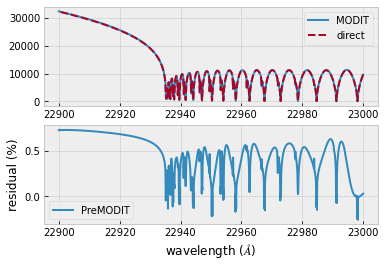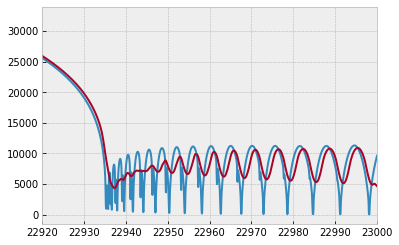Forward Modelling of a Spectrum using PreMODIT and Comparison with LPF¶
Here, we try to compute a emission spectrum using PreMODIT. Note that PreMODIT is a beta release. Presumably, we will improve it and release better one in ExoJAX 2.
from jax.config import config
config.update("jax_enable_x64", True)
from exojax.spec import rtransfer as rt
from exojax.spec import premodit
import numpy as np
import matplotlib.pyplot as plt
plt.style.use('bmh')
#ATMOSPHERE
NP=100
T0=1295.0 #K
Parr, dParr, k=rt.pressure_layer(NP=NP)
Tarr = T0*(Parr)**0.1
We set a wavenumber grid using wavenumber_grid. Specify xsmode=“dit” though it is not mandatory. DIT uses FFT, so the (internal) wavenumber grid should be linear. But, you can also use a nonlinear grid. In this case, the interpolation (jnp.interp) is used.
from exojax.utils.grids import wavenumber_grid
nus,wav,R=wavenumber_grid(22900,23000,10000,unit="AA",xsmode="premodit")
xsmode assumes ESLOG in wavenumber space: mode=premodit
Loading a molecular database of CO and CIA (H2-H2)… For PreMODIT, gpu_transfer=False can save the device memory use.
from exojax.spec import api, contdb
mdbCO=api.MdbExomol('.database/CO/12C-16O/Li2015',nus,gpu_transfer=False)
cdbH2H2=contdb.CdbCIA('.database/H2-H2_2011.cia',nus)
Background atmosphere: H2
Reading .database/CO/12C-16O/Li2015/12C-16O__Li2015.trans.bz2
.broad is used.
Broadening code level= a0
default broadening parameters are used for 71 J lower states in 152 states
H2-H2
from exojax.spec import molinfo
molmassCO=molinfo.molmass("CO")
Computing the relative partition function,
from jax import vmap
qt=vmap(mdbCO.qr_interp)(Tarr)
PreMODIT precomputes a kind of the line shape density, called LBD (line basis density). init_premodit easily does that.
from exojax.spec.initspec import init_premodit
interval_contrast = 0.1
dit_grid_resolution = 0.1
Ttyp = 2000.0
lbd, multi_index_uniqgrid, elower_grid, ngamma_ref_grid, n_Texp_grid, R, pmarray = init_premodit(
mdbCO.nu_lines,
nus,
mdbCO.elower,
mdbCO.alpha_ref,
mdbCO.n_Texp,
mdbCO.Sij0,
Ttyp,
interval_contrast=interval_contrast,
dit_grid_resolution=dit_grid_resolution,
warning=False)
uniqidx: 100%|██████████| 1/1 [00:00<00:00, 11066.77it/s]
Let’s compute a cross section matrix, i.e. cross sections in all of the layers.
xsm = premodit.xsmatrix(Tarr, Parr, R, pmarray, lbd, nus, ngamma_ref_grid,
n_Texp_grid, multi_index_uniqgrid, elower_grid, molmassCO, qt)
Then, let’s compute the opacity delta tau. Here, we need to assume gravity and Mass Mixing Ratio :)
from exojax.spec.rtransfer import dtauM
g = 2478.57 # gravity
MMR = 0.1
dtau = dtauM(dParr, xsm, MMR * np.ones_like(Parr), molmassCO, g)
We also compute the cross section using the direct computation (LPF) for the comparison purpose.
#direct LPF for comparison
#Reload mdb beacuse we need gpu_transfer for LPF. This makes big difference in the device memory use.
mdbCO=api.MdbExomol('.database/CO/12C-16O/Li2015',nus, gpu_transfer=True)
#we need sigmaDM for LPF
from exojax.spec import doppler_sigma
from jax import jit
from exojax.spec.initspec import init_lpf
from exojax.spec.lpf import xsmatrix as xsmatrix_lpf
from exojax.spec.exomol import gamma_exomol
from exojax.spec import gamma_natural
from exojax.spec import SijT
# Strength, Dopper width, and Lorentian width
SijM=jit(vmap(SijT,(0,None,None,None,0)))\
(Tarr,mdbCO.logsij0,mdbCO.nu_lines,mdbCO.elower,qt)
sigmaDM=jit(vmap(doppler_sigma,(None,0,None)))\
(mdbCO.nu_lines,Tarr,molmassCO)
gammaLMP = jit(vmap(gamma_exomol,(0,0,None,None)))\
(Parr,Tarr,mdbCO.n_Texp,mdbCO.alpha_ref)
gammaLMN=gamma_natural(mdbCO.A)
gammaLM=gammaLMP+gammaLMN[None,:]
numatrix=init_lpf(mdbCO.nu_lines,nus)
xsmdirect=xsmatrix_lpf(numatrix,sigmaDM,gammaLM,SijM)
Background atmosphere: H2
Reading .database/CO/12C-16O/Li2015/12C-16O__Li2015.trans.bz2
.broad is used.
Broadening code level= a0
default broadening parameters are used for 71 J lower states in 152 states
Let’s see the cross section matrix!
import numpy as np
import matplotlib.pyplot as plt
fig=plt.figure(figsize=(20,4))
ax=fig.add_subplot(211)
c=plt.imshow(np.log10(xsm),cmap="bone_r",vmin=-23,vmax=-19)
plt.colorbar(c,shrink=0.8)
plt.text(50,30,"PreMODIT")
ax.set_aspect(0.1/ax.get_data_ratio())
ax=fig.add_subplot(212)
c=plt.imshow(np.log10(xsmdirect),cmap="bone_r",vmin=-23,vmax=-19)
plt.colorbar(c,shrink=0.8)
plt.text(50,30,"DIRECT")
ax.set_aspect(0.1/ax.get_data_ratio())
plt.show()

from exojax.spec import planck
from exojax.spec.rtransfer import rtrun
sourcef = planck.piBarr(Tarr,nus)
F0=rtrun(dtau,sourcef)
#also for LPF
dtaumdirect=dtauM(dParr,xsmdirect,MMR*np.ones_like(Tarr),molmassCO,g)
F0direct=rtrun(dtaumdirect,sourcef)
The difference is very small except around the edge (even for this it’s only 1%).
fig=plt.figure()
ax=fig.add_subplot(211)
plt.plot(wav[::-1],F0,label="MODIT")
plt.plot(wav[::-1],F0direct,ls="dashed",label="direct")
plt.legend()
ax=fig.add_subplot(212)
plt.plot(wav[::-1],(F0-F0direct)/np.median(F0direct)*100,label="PreMODIT")
plt.legend()
#plt.ylim(-0.1,0.1)
plt.ylabel("residual (%)")
plt.xlabel("wavelength ($\AA$)")
plt.show()

applying an instrumental response and planet/stellar rotation to the raw spectrum
from exojax.spec import response
from exojax.utils.constants import c
import jax.numpy as jnp
wavd=jnp.linspace(22920,23000,500) #observational wavelength grid
nusd = 1.e8/wavd[::-1]
RV=10.0 #RV km/s
vsini=20.0 #Vsini km/s
u1=0.0 #limb darkening u1
u2=0.0 #limb darkening u2
Rinst=100000.
beta=c/(2.0*np.sqrt(2.0*np.log(2.0))*Rinst) #IP sigma need check
Frot=response.rigidrot(nus,F0,vsini,u1,u2)
F=response.ipgauss_sampling(nusd,nus,Frot,beta,RV)
plt.plot(wav[::-1],F0)
plt.plot(wavd[::-1],F)
plt.xlim(22920,23000)
(22920.0, 23000.0)
